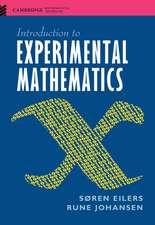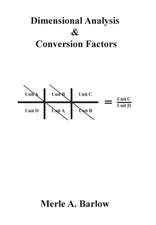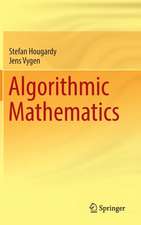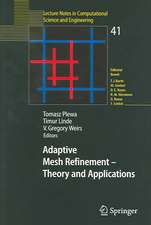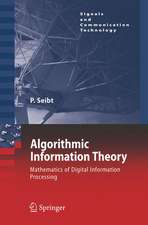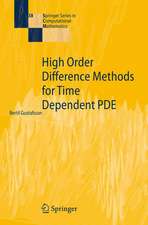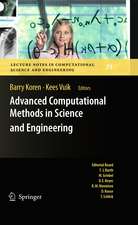Fundamentals of Scientific Computing: Texts in Computational Science and Engineering, cartea 8
Autor Bertil Gustafssonen Limba Engleză Paperback – 3 aug 2013
How is it possible to predict weather patterns for tomorrow, with access solely to today’s weather data? And how is it possible to predict the aerodynamic behavior of an aircraft that has yet to be built?
The answer is computer simulations based on mathematical models – sets of equations – that describe the underlying physical properties. However, these equations are usually much too complicated to solve, either by the smartest mathematician or the largest supercomputer. This problem is overcome by constructing an approximation: a numerical model with a simpler structure can be translated into a program that tells the computer how to carry out the simulation.
This book conveys the fundamentals of mathematical models, numerical methods and algorithms. Opening with a tutorial on mathematical models and analysis, it proceeds to introduce the most important classes of numerical methods, with finite element, finite difference and spectral methods as central tools. The concluding section describes applications in physics and engineering, including wave propagation, heat conduction and fluid dynamics. Also covered are the principles of computers and programming, including MATLAB®.
| Toate formatele și edițiile | Preț | Express |
|---|---|---|
| Paperback (1) | 390.84 lei 6-8 săpt. | |
| Springer Berlin, Heidelberg – 3 aug 2013 | 390.84 lei 6-8 săpt. | |
| Hardback (1) | 396.40 lei 6-8 săpt. | |
| Springer Berlin, Heidelberg – 12 iun 2011 | 396.40 lei 6-8 săpt. |
Din seria Texts in Computational Science and Engineering
-
 Preț: 400.26 lei
Preț: 400.26 lei - 19%
 Preț: 544.68 lei
Preț: 544.68 lei - 4%
 Preț: 466.32 lei
Preț: 466.32 lei - 20%
 Preț: 325.00 lei
Preț: 325.00 lei - 15%
 Preț: 595.86 lei
Preț: 595.86 lei - 20%
 Preț: 588.53 lei
Preț: 588.53 lei -
 Preț: 389.11 lei
Preț: 389.11 lei -
 Preț: 416.01 lei
Preț: 416.01 lei -
 Preț: 430.21 lei
Preț: 430.21 lei -
 Preț: 439.07 lei
Preț: 439.07 lei -
 Preț: 451.55 lei
Preț: 451.55 lei -
 Preț: 494.11 lei
Preț: 494.11 lei - 15%
 Preț: 608.08 lei
Preț: 608.08 lei -
 Preț: 394.87 lei
Preț: 394.87 lei -
 Preț: 393.90 lei
Preț: 393.90 lei -
 Preț: 387.75 lei
Preț: 387.75 lei -
 Preț: 504.50 lei
Preț: 504.50 lei -
 Preț: 396.62 lei
Preț: 396.62 lei -
 Preț: 482.45 lei
Preț: 482.45 lei - 20%
 Preț: 338.03 lei
Preț: 338.03 lei -
 Preț: 498.91 lei
Preț: 498.91 lei -
 Preț: 398.35 lei
Preț: 398.35 lei
Preț: 390.84 lei
Nou
Puncte Express: 586
Preț estimativ în valută:
74.79€ • 78.44$ • 62.26£
74.79€ • 78.44$ • 62.26£
Carte tipărită la comandă
Livrare economică 01-15 aprilie
Preluare comenzi: 021 569.72.76
Specificații
ISBN-13: 9783642268649
ISBN-10: 3642268641
Pagini: 340
Ilustrații: XIV, 326 p.
Dimensiuni: 155 x 235 x 18 mm
Greutate: 0.48 kg
Ediția:2011
Editura: Springer Berlin, Heidelberg
Colecția Springer
Seria Texts in Computational Science and Engineering
Locul publicării:Berlin, Heidelberg, Germany
ISBN-10: 3642268641
Pagini: 340
Ilustrații: XIV, 326 p.
Dimensiuni: 155 x 235 x 18 mm
Greutate: 0.48 kg
Ediția:2011
Editura: Springer Berlin, Heidelberg
Colecția Springer
Seria Texts in Computational Science and Engineering
Locul publicării:Berlin, Heidelberg, Germany
Public țintă
Lower undergraduateCuprins
Part I Models and elementary mathematics.- Part II Fundamentals in numerical analysis.- Part III Numerical methods for differential equations.- Part IV Numerical methods for algebraic equations.- Part V Applications.- References.- Index
Recenzii
From the reviews:
“Scientific computing is considered to comprise mathematical modeling, numerical analysis as well as issues of programming and implementation. Correspondingly, the book introduces all areas required and structures the material in 5 parts, altogether comprising 19 chapters. … In summary, the books presents the fundamentals of scientific computing in such a way that students from mathematics as well as from science or engineering can benefit.” (Gudula Rünger, Zentralblatt MATH, March, 2012)
“Scientific computing is considered to comprise mathematical modeling, numerical analysis as well as issues of programming and implementation. Correspondingly, the book introduces all areas required and structures the material in 5 parts, altogether comprising 19 chapters. … In summary, the books presents the fundamentals of scientific computing in such a way that students from mathematics as well as from science or engineering can benefit.” (Gudula Rünger, Zentralblatt MATH, March, 2012)
Notă biografică
Top CSE scientist
Textul de pe ultima copertă
The book of nature is written in the language of mathematics -- Galileo Galilei
How is it possible to predict weather patterns for tomorrow, with access solely to today’s weather data? And how is it possible to predict the aerodynamic behavior of an aircraft that has yet to be built?
The answer is computer simulations based on mathematical models – sets of equations – that describe the underlying physical properties. However, these equations are usually much too complicated to solve, either by the smartest mathematician or the largest supercomputer. This problem is overcome by constructing an approximation: a numerical model with a simpler structure can be translated into a program that tells the computer how to carry out the simulation.
This book conveys the fundamentals of mathematical models, numerical methods and algorithms. Opening with a tutorial on mathematical models and analysis, it proceeds to introduce the most important classes of numerical methods, with finite element, finite difference and spectral methods as central tools. The concluding section describes applications in physics and engineering, including wave propagation, heat conduction and fluid dynamics. Also covered are the principles of computers and programming, including MATLAB®.
How is it possible to predict weather patterns for tomorrow, with access solely to today’s weather data? And how is it possible to predict the aerodynamic behavior of an aircraft that has yet to be built?
The answer is computer simulations based on mathematical models – sets of equations – that describe the underlying physical properties. However, these equations are usually much too complicated to solve, either by the smartest mathematician or the largest supercomputer. This problem is overcome by constructing an approximation: a numerical model with a simpler structure can be translated into a program that tells the computer how to carry out the simulation.
This book conveys the fundamentals of mathematical models, numerical methods and algorithms. Opening with a tutorial on mathematical models and analysis, it proceeds to introduce the most important classes of numerical methods, with finite element, finite difference and spectral methods as central tools. The concluding section describes applications in physics and engineering, including wave propagation, heat conduction and fluid dynamics. Also covered are the principles of computers and programming, including MATLAB®.
Caracteristici
Explanations of the most basic and fundamental mathematical and numerical principles that makes a thorough understanding of advanced methods easy A unified approach demonstrating the power of mathematics when applied to different types of problems in mathematical and numerical analysis An introductory tutorial for those who have forgotten their calculus and linear algebra, or never had much of it Presentation of important applications in physics and engineering, representing the most significant types of mathematical models Numerous illustrations for ease of understanding Includes supplementary material: sn.pub/extras



